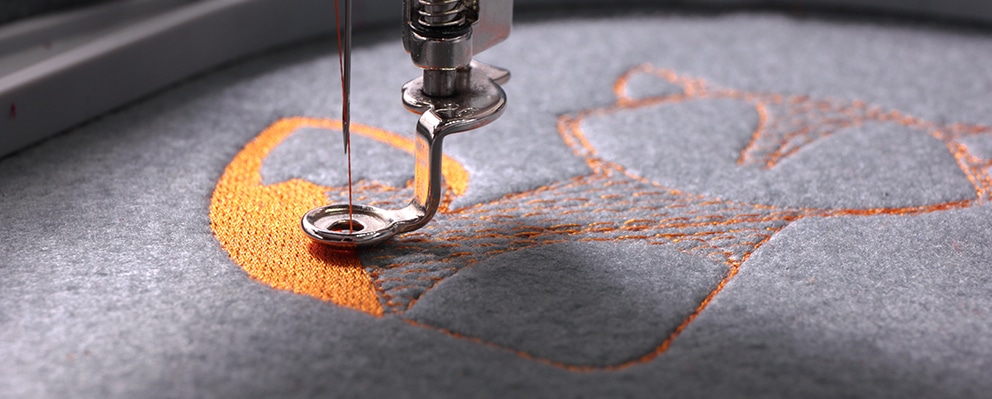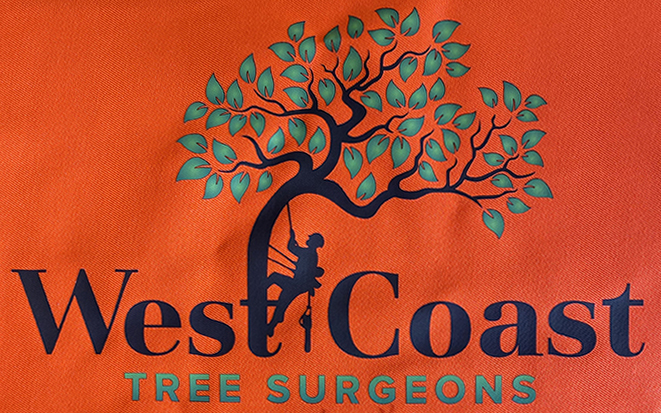- Free delivery for orders over £100
- Customised in the UK
- No minimum order
- Customised in the UK
- No minimum order
- Free delivery for orders over £100

Share this post
When it comes to branding your team’s uniforms or workwear, a crucial decision you’ll face is how to apply your company logo. The two main options are embroidery and printing, each with its own set of advantages and disadvantages. Choosing the right method depends on your budget, the type of garment, and the desired look and feel.

Embroidery needle in action. Each design is constructed of thousands of tiny stitches. Our machines can run up to 10 colours per logo, and embroider up to 8 garments on each run of the machine.
When it comes to branding your team’s uniforms or workwear, a crucial decision you’ll face is how to apply your company logo. The two main options are embroidery and printing, each with its own set of advantages and disadvantages. Choosing the right method depends on your budget, the type of garment, and the desired look and feel.
Embroidery: The Mark of Professionalism
Embroidery involves stitching your logo directly onto the fabric using threads. This method is the gold standard for a premium, professional appearance.
Durability: Embroidered logos are incredibly durable. They won’t crack, fade, or peel, making them ideal for workwear that undergoes frequent washing and heavy use. The stitching holds up well against wear and tear, ensuring your brand looks sharp for a long time.
Aesthetic: Embroidery provides a high-end, textured look that adds a touch of class to polo shirts, jackets, and hats. The raised texture of the thread gives the logo a sophisticated, three-dimensional quality.
Best for: Most workwear fabrics like polo shirts, hoodies fleeces, jackets, and hats. The stability of these materials is perfect for the dense stitching required for logo embroidery.
On the downside, embroidery is not always suitable for very large, complex logo designs because this can be costly. It’s also not so suitable for very complex designs that require patterns of shading or very fine details.
We will take a look at techniques such as traditional screen-printing, plus more modern developments such as DTG and DTF (Direct to Film) transfer prints

Screen-printing, a popular printing technique, involves pushing ink through a stencilled silk screen mesh onto the fabric.
Vibrancy and Cost-Effectiveness: Screen-printing is excellent for large, bold logo designs with solid blocks of colour. The colours are vibrant and opaque, standing out clearly on the garment. It’s also the most economical option for large-volume orders, as the setup cost of manufacturing silk screens is spread out over many items.
Feel: The ink lies on top of the fabric, creating a smooth finish. It’s less textured than embroidery.
Best for: T-shirts, hoodies, and larger logo designs that require bright, solid block of colours. It’s a great choice for promotional giveaways and team events where you need a large quantity of branded apparel.
A slight drawback of screen-printing is its durability compared to embroidery. The print may crack or fade slightly over time, especially with frequent washing, giving the classic appearance of that old favorite band t-shirt that you love!
Screen printing is also not ideal for designs with many colours or intricate details, as each colour requires a separate screen.

Transfer prints, such as vinyl transfers, DTF (Direct to Film) transfers, and digital prints, offer flexibility and a cost-effective alternative to traditional methods.
Versatility: Transfers can be applied to many fabrics (not fleece) and are perfect for complex, and full colour logos including shading effects and very fine details. Methods like DTF transfers can reproduce fine logo details and gradients with exceptional clarity.
Low Volume and Customisation: These methods are good for relatively small orders or even one-off customisation, as the set-up costs are relatively low provided there is goo artwork to work from.
Best for: Lightweight fabrics, complex logos, and smallish batch orders. They work well on sportswear, tote bags, and garments that need a soft, stretchy non-bulky finish.
While modern transfers are being engineered to be more and more durable, they do not have quite the same longevity as high-quality embroidery. These logos should always last the life of the garment, but over time can become slightly cracked and faded.
The feel can also vary, with some vinyl logo transfers having a slightly “plasticky” feel, though newer technologies like DTF transfers are significantly softer.
The Final Decision
When choosing between embroidery and printing, consider the following:
Garment Type: For durable workwear like polo shirts, sweatshirts, overalls and jackets, embroidery usually offers a long-lasting, professional finish. For lighter weight t-shirts and big bold graphics screen-printing or transfers are often more suitable.
Logo Complexity: If your logo has fine details or gradients, a transfer print will likely be the best option. For a simple, bold logo, screen-printing is effective.
Budget and Quantity: For smaller, premium orders, and for smaller sized simple logos embroidery is usually a great investment. For larger size logos, or budget-conscious bulk projects, printing can be more cost-effective.
Ultimately, it is best to make use of our 40+ years of experience to guide you towards the best decision, one that aligns with your company’s image, budget, and the specific needs of your workwear.
To discuss your requirements please give us a call during office hours and speak to Tim. Or complete one of the contact forms on our website.
Custom clothing specialists since 1928, offering a wide range of apparel including high-vis, waterproofs, fire-retardant clothing, footwear and PPE. Embroidered and Printed customisation options are available.